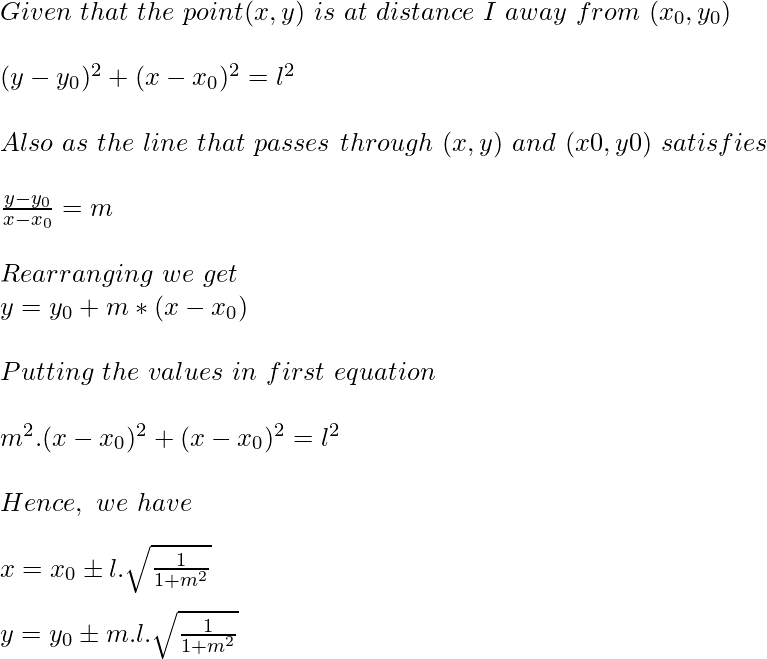给定二维点 p(x 0 , y 0 ) 的坐标。找出离它距离为 L 的点,使得连接这些点形成的线的斜率为 M。
例子:
Input : p = (2, 1)
L = sqrt(2)
M = 1
Output :3, 2
1, 0
Explanation:
The two points are sqrt(2) distance away
from the source and have the required slope
m = 1.
Input : p = (1, 0)
L = 5
M = 0
Output : 6, 0
-4, 0我们需要在斜率为 M 的直线上找到与给定点相距 L 的两个点。
这个想法已在下面的帖子中介绍。
使用中点找到矩形的角
根据输入斜率,问题可以分为 3 类。
- 如果斜率为零,我们只需要调整源点的x坐标
- 如果斜率无限大,我们需要调整y坐标
- 对于斜率的其他值,我们可以使用以下等式来找到点

现在使用上面的公式我们可以找到所需的点。
C++
// C++ program to find the points on a line of
// slope M at distance L
#include
using namespace std;
// structure to represent a co-ordinate
// point
struct Point {
float x, y;
Point()
{
x = y = 0;
}
Point(float a, float b)
{
x = a, y = b;
}
};
// Function to print pair of points at
// distance 'l' and having a slope 'm'
// from the source
void printPoints(Point source, float l,
int m)
{
// m is the slope of line, and the
// required Point lies distance l
// away from the source Point
Point a, b;
// slope is 0
if (m == 0) {
a.x = source.x + l;
a.y = source.y;
b.x = source.x - l;
b.y = source.y;
}
// if slope is infinite
else if (m == std::numeric_limits
::max()) {
a.x = source.x;
a.y = source.y + l;
b.x = source.x;
b.y = source.y - l;
}
else {
float dx = (l / sqrt(1 + (m * m)));
float dy = m * dx;
a.x = source.x + dx;
a.y = source.y + dy;
b.x = source.x - dx;
b.y = source.y - dy;
}
// print the first Point
cout << a.x << ", " << a.y << endl;
// print the second Point
cout << b.x << ", " << b.y << endl;
}
// driver function
int main()
{
Point p(2, 1), q(1, 0);
printPoints(p, sqrt(2), 1);
cout << endl;
printPoints(q, 5, 0);
return 0;
} Java
// Java program to find the points on
// a line of slope M at distance L
class GFG{
// Class to represent a co-ordinate
// point
static class Point
{
float x, y;
Point()
{
x = y = 0;
}
Point(float a, float b)
{
x = a;
y = b;
}
};
// Function to print pair of points at
// distance 'l' and having a slope 'm'
// from the source
static void printPoints(Point source,
float l, int m)
{
// m is the slope of line, and the
// required Point lies distance l
// away from the source Point
Point a = new Point();
Point b = new Point();
// Slope is 0
if (m == 0)
{
a.x = source.x + l;
a.y = source.y;
b.x = source.x - l;
b.y = source.y;
}
// If slope is infinite
else if (Double.isInfinite(m))
{
a.x = source.x;
a.y = source.y + l;
b.x = source.x;
b.y = source.y - l;
}
else
{
float dx = (float)(l / Math.sqrt(1 + (m * m)));
float dy = m * dx;
a.x = source.x + dx;
a.y = source.y + dy;
b.x = source.x - dx;
b.y = source.y - dy;
}
// Print the first Point
System.out.println(a.x + ", " + a.y);
// Print the second Point
System.out.println(b.x + ", " + b.y);
}
// Driver code
public static void main(String[] args)
{
Point p = new Point(2, 1),
q = new Point(1, 0);
printPoints(p, (float)Math.sqrt(2), 1);
System.out.println();
printPoints(q, 5, 0);
}
}
// This code is contributed by Rajnis09C#
// C# program to find the points on
// a line of slope M at distance L
using System;
class GFG{
// Class to represent a co-ordinate
// point
public class Point
{
public float x, y;
public Point()
{
x = y = 0;
}
public Point(float a, float b)
{
x = a;
y = b;
}
};
// Function to print pair of points at
// distance 'l' and having a slope 'm'
// from the source
static void printPoints(Point source,
float l, int m)
{
// m is the slope of line, and the
// required Point lies distance l
// away from the source Point
Point a = new Point();
Point b = new Point();
// Slope is 0
if (m == 0)
{
a.x = source.x + l;
a.y = source.y;
b.x = source.x - l;
b.y = source.y;
}
// If slope is infinite
else if (Double.IsInfinity(m))
{
a.x = source.x;
a.y = source.y + l;
b.x = source.x;
b.y = source.y - l;
}
else
{
float dx = (float)(l / Math.Sqrt(
1 + (m * m)));
float dy = m * dx;
a.x = source.x + dx;
a.y = source.y + dy;
b.x = source.x - dx;
b.y = source.y - dy;
}
// Print the first Point
Console.WriteLine(a.x + ", " + a.y);
// Print the second Point
Console.WriteLine(b.x + ", " + b.y);
}
// Driver code
public static void Main(String[] args)
{
Point p = new Point(2, 1),
q = new Point(1, 0);
printPoints(p, (float)Math.Sqrt(2), 1);
Console.WriteLine();
printPoints(q, 5, 0);
}
}
// This code is contributed by Amit Katiyar输出:
3, 2
1, 0
6, 0
-4, 0